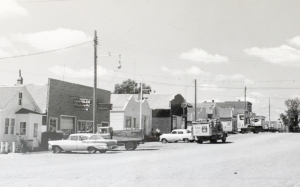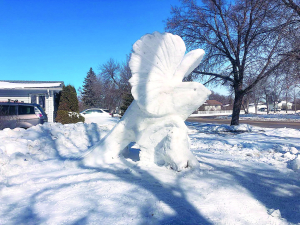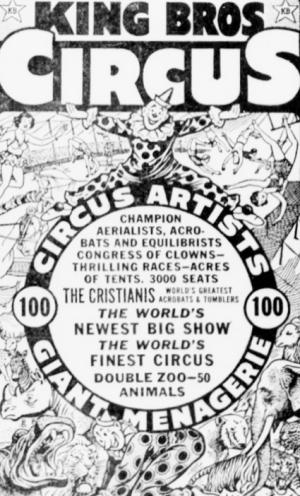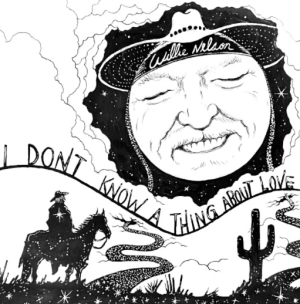Submitted
Doggy Donation
Swan Valley Animal Protection League (SVAPL) member Nikki Chartrand (left) receives a $10,000 cheque from Dan Grazier (right) who is a member of the Swan River Kinsmen Club as well as the SVAPL. “These are two organizations that I am proud to be affiliated with and who do such great things in our community,” said Grazier. “After a presentation, the Kinsmen voted unanimously to fully fund the “Kinsmen Kennel,” a large dog run that will be constructed behind the shelter to help our pooch friends. Thank you so much to these two groups for all that you do, and a real “Big Kin” to the Swan River Kinsmen Club for stepping up on this project that would have taken us years to fund otherwise!”...
National Champions
The Swan Valley boasts two new national champions as members of Lidstone Combat Sports Academy (LCSA) return from the World Association of Kickboxing Organizations (WAKO) Canada National Championship with two championship belts. Here, competitors Liam Peterson (left), John Walsh (second from left) and Cole Lumax (right) are pictured with coach Travis Lumax (second from right) in front of Niagra Falls where the competition was held.
Travelling the “Turkey Trail” was always an adventure
By Ed Stozek
For the Herald
Provincial Trunk Highway 45 has greatly improved from its original narrow and winding nature.
The Russell-Erickson road was dubbed by locals as the “Turkey Trail” claiming it reminded them of the bush paths commonly found on Prairie farms.
Another possible name origin stemmed from an incident where “a truck loaded with live turkeys went off the road and rolled over, from which the turkeys escaped.” (The Manitoba Historical Society Archives)
Construction began in 1937 and eventually the Turkey Trail linked the communities of Russell, Silverton, Angusville, Rossburn, Vista, Oakburn, Menzie, Elphinstone, Sandy Lake and Rackham.
By 1966 the road generally aligned with the railway line. Many of the sharp curves and unnecessary turns were removed allowing for a more stream-lined journey.
As a young boy growing up in the Oakburn district sections of the Turkey Trail were utilized on a Saturday afternoon for family outings to the surrounding communities. A longer adventure included the annual spring trip to Russell to pick up chicken and turkey chicks at Berg’s Hatchery.
From 1967 to 1970 my Grades 10 to 12 high school routine included a daily school bus ride on the new and upgraded PTH 45 from Oakburn to Elphinstone. In my Grade 12 year I drove my parent’s car in the latter part of June to write the Provincial exams at the collegiate. I can still recall taking the short cut and driving the side roads of the original Turkey Trail to Elphinstone.
Automobile travel during the winter months on the Turkey Trail presented problems for the locals.
“A variety of horse-drawn vans were regularly coming to town due to poor road conditions. All week the Turkey Trail had been blocked to car travel owing to extremely heavy snow and drifting. The mail-truck driver certainly merited commendation for getting the mail through even when the bus didn’t make it. The condition of side roads was hopeless as far as car travel was concerned.” (Dec. 15, 1955, Rossburn Review)
The winter of 1955-56 continued with more major storms. An article in the April 5, 1956, edition of the Rossburn Review indicated that highway isolation ended on Apr. 4 when the Royal Mail truck reached town over the Turkey Trail which was opened from Russell by bulldozers.
It was the first mail received since Mar. 26, and it was also the date when a passenger bus was last seen in town. The fact that mail was not received for seven days magnified the situation. Rail service had been established five days ahead of highway traffic.
“The delay in opening the road until the sun had caused the snow to pack had the townspeople and surrounding area residents practically up in arms. Something definitely slipped in the allocation of snowplows. It is thus that Easter 1956, in part as it affects the re-uniting of families for a few days, was a disappointment to hundreds of families in the Rossburn, Angusville, Vista and Oakburn area.”
The area had been completely isolated except for the one passenger train arriving at Rossburn packed with holidayers.
“Many had started the first leg of their journey by bus in complete belief the government road equipment would open the highway and then they could return by bus on Sunday.”
The editor of the Rossburn Review expressed the time had come for communities located along the Turkey Trail to take immediate action with regards to the numerous benefits of gaining provincial highway status. Thousands of dollars in the past month had been added to provincial coffers from these communities from licenses for cars and the recent gasoline tax increased by two cents. He also noted the local MLA’s present lack of a stand publicly to date regarding the Turkey Trail’s status was damaging every affected community.
By 1959 the Russell-Erickson road officially became PTH No. 45 and today it is a well-travelled two-lane paved highway.
Driving past my old stomping grounds evokes memories of the Turkey Trail and the trip with my father to Berg’s Hatchery. Using the Chevy sedan we brought the chicks home in special perforated cardboard boxes. None escaped but they were a hungry and a thirsty bunch when we arrived home.
Hoppy Easter
Captured during Easter weekend, a wild rabbit sits around a silage pile on a Swan Valley West farm
Can you Imagine?
Swan School of Dance held their annual recital last Wednesday (March 20) at the SVRSS gymnasium. Dancing to songs that related to the theme ‘Imagine...’ the performers put
on a spectacular show for the audience who filled the space.
Provincial Gold
The Swan Valley U15 Stampeders went undefeated during the weekend of March 1-3, bringing home the Championship banner from the U15 Rural B Provincials in Russell. The team captured the title after defeating the Minnedosa Bombers 3-1.
Snowbirds
Winter almost came and went without Swan River sculptor Derryl May crafting another creation in his front yard, with last week’s precipitation providing a medium to erect a representation of an osprey catching a fish, which melted down somewhat and re-envisioned into a chickadee. Here, the final result before the above-freezing temperatures melted it further.
Always exciting when the circus comes to town
By: Ed Stozek
For The Herald
Featuring trained animals and various other thrilling performances, the offer of free tickets to attend the circus was part of the excitement that my wife Janice and her fellow Grades 1 to 8 students experienced during the early 1960s. A large crowd aided local organizations in their fund-raising projects.
An open letter in the Dauphin Herald and Press by the Dauphin Junior Chamber of Commerce advertised the impending arrival of the King Brothers Circus with performances scheduled for 3:30 p.m. and 8 p.m. on Monday, June 20, 1960. Special convoys used for the transportation of 50 wild animals, circus artists and equipment soon followed.
Under supervision by the Dauphin Jaycees the proceeds from ticket sales were to be used for the Jaycee Little League Baseball Park.
Two years later the Shrine Circus was scheduled to arrive for its first ever appearance in Dauphin. Sponsored by the Dauphin and District Shrine Club the Gil Gray Shrine Circus commenced on Wednesday, May 23, with matinee and evening performances at the DMCC arena. The 2-1/2 hour shows featured 46 acts suitable for all round family entertainment.
Business firms and merchants had been contacted earlier with requests to help in sponsoring children’s tickets in accordance with a plan used in other centres where the Shrine Circus was an annual event. All proceeds from this new community project were earmarked for the Children’s Hospital in Winnipeg.
In mid-April a representative from the Shrine Circus organization, as well as two local members from Dauphin visited Ste. Rose to make preliminary arrangements for the distribution of children’s tickets by the town businesses. Since it was a first for the Shrine Circus to come to the area a large number of attendees were anticipated. In previous years one had to travel to Brandon or Winnipeg to attend the Shrine Circus. Dauphin’s ticket prices included $1.50 for adults and $1 for Grades 9 to 12 students. Tickets were available at the arena box office with no reserve seating. It was “first there, first served.”
One year later, on May 29, 1963, the Shrine Circus made its second appearance at Dauphin with local sponsors guaranteeing more than 3,000 free tickets to school age children for the action filled shows. For the second year the Shrine Club had been helped by sponsors who bought the tickets and distributed them to the elementary schools in the area.
“In addition to the 1,300 pupils in Grades 1 to 8 in Dauphin, tickets were also distributed as far east as McCreary, north to Winnipegosis and Pine River, west to Grandview and south to the park.” (May 29, 1963, The Dauphin Herald and Press)
The first performance at 1 p.m. at the DMCC arena was filled to capacity. The ensuing shows at 4 p.m. and 8 p.m. also anticipated a “full house” as families were encouraged to attend.
At a Shriner’s social event held at the King’s Hotel on June 22, 1964, John Gardner outlined the concept of a Shriner’s hospital for handicapped children and indicated that the first hospital was opened in Louisiana in 1922 to treat children irrespective of race, creed or colour. In 1925 the Khartum Temple developed a mobile unit in Winnipeg based out of the Children’s Hospital. By 1949 the project of a new self-contained Shriner’s for Handicapped Children’s Hospital was completed.
Located at 633 Wellington Crescent it replaced facilities at the Children’s Hospital and was turned over to the board of trustees in 1950 making the only occasion in all of Shriner history where a project was fully paid and completely free of debt. Gardner noted that 4,700 young children had already been treated.
The facility operated until 1977 when it was turned over to the provincial government and renamed the Rehabilitation Centre for Children. It closed in May 2016, and the buildings stood vacant, except for occasional use as movie sets, until being demolished in October 2022.
During the 1980s and 90s, Janice and I took our children to enjoy the Shrine Circus at the DMCC. Several years ago, we accompanied our grandson to a performance culminating three generations of our family members enjoying the sights, sounds and action associated with the circus.
Just three chords and the truth . . .
By Ed Stozek
For The Herald
Produced and directed by filmmaker Ken Burns, best known for his documentary films and television series chronicling American history and culture, PBS aired the first of eight two-hour episodes of Country Music on Sept. 15, 2019.
Along with the music and recording artists, the documentary also featured unforgettable stories based on the hardships and joys shared by everyday people.
Many of those stories became the basis for many country songs. The first episode, Beginnings-1933, introduced the first “hillbilly music” rising stars and included ballads, hymns and stories of the Carter Family, as well as Jimmie Rodgers and his combination of blues and yodelling.
The ensuing seven episodes covered a variety of country artists and some of my favourites, Hank Williams, Johnny Cash, The Judds, Garth Brooks, and Willie Nelson.
In one interview Willie Nelson referred to a quote originally made by Harlan Howard. “1950s country music is three chords and the truth.”
Howard originally noted that he was captured by the songs as much as by the singer. “They grabbed my heart. The reality of country music moved me. Even when I was a kid, I liked the sad songs, songs that talked about true life. I recognized this music as a simple plea. It beckoned me.”
Howard completed only nine years of formal education, though he was an avid reader. When he was 12 years of age, he began writing songs, “an enthusiasm fueled by an appetite for books and an ear for a telling phrase. I take a whole life story and compress it into three minutes.”
Howard became a songwriter mainly composing country music songs in a career spanning six decades with over 4,000 songs to his credit.
In 1961 Harlan Howard had 15 compositions on the country music charts. Some of Howard’s songs became country music standards including “I Fall To Pieces” (Patsy Cline), “I’ve Got A Tiger By The Tail” (Buck Owens), “Heartaches By The Number” (Ray Price), “Why Not Me?” (The Judds) and “Somewhere Tonight” (Highway 101).
On Mar. 23, 2023, Willie Nelson released his 73rd studio album, a tribute to Harlan Howard entitled, “I Don’t Know A Thing About Love: The Songs of Harlan Howard.”
Willie’s first job as a songwriter was initiated by Harlan Howard for the publishing company, Pamper Music. Willie Nelson ended up composing many songs that only had three chords and other originals such as “Crazy” that were very complex. Seeing Willie perform at the Minot State Fair in the early 1990s was a memorable musical highlight. We also made several trips to see other country recording artists including Reba McIntyre, Kenny Rogers, Highway 101, Garth Brooks and The Judds.
Another Harlan Howard quote noted, “A lot of songs you write are just for exercise - just pencil sharpeners.” As a person who has dabbled in writing poetry and songs, it always is a great deal of fun “noodling” on the guitar and writing down ideas. One can spend a great deal of time and energy trying to elaborate on a song idea. As Harlan would say it, “I’m always collecting emotions for future reference.”
As a young boy I recall one of my mother’s notebooks with her beautiful handwriting and the lyrics to many of her favourite songs including “Red River Valley,” “You Are My Sunshine” and “Keep On The Sunny Side.”
After ordering an acoustic guitar from the Eaton’s catalogue, it was a challenge to learn how to play it. In an era long before computers and the Internet one had to rely on other options of how to tune a guitar, learning those three basic chords and figuring out where they fit in a song. “Keep On The Sunny Side” was one of the first songs that I learned to play. It also helped that my sister had a Carter Family record for me to listen to.
I enjoy playing the three chord songs and especially lyrics that tell a story.
There’s an old joke. What do you get back when you play country music backwards? Your wife returns, your dog comes back to life, and you get out of prison.
Just three chords and the truth.
Shelterbelts - a problem solver and a big part of Prairie history
By Ed Stozek
In 1918 a group of Western Canadians met at Winnipeg to solve an urgent problem.
They wanted every prairie farmer to gain knowledge of the value of shelterbelts for home improvement, productive gardens, more pleasant living conditions and the betterment of farm values.
The Canadian Pacific Railway agreed to provide a railway car to the Forestry Association of Western Canada and along with the Canadian National Railway agreed to move the “classroom on wheels” free of charge to communities located by their tracks.
The railroad car was designed as a travelling classroom including living quarters for the “travelling lecturer.” Long rows of seats were set up like a motion picture theatre with a screen at the front and an operating booth at the rear. This facilitated the showing of lantern slides and motion pictures promoting the benefits of tree planting, forestry and shelterbelts.
The travelling lecturer planned and delivered the presentations, kept daily records and produced annual reports. One report noted, “Last summer a Tree Planting Car (TPC) was sent on a trip over the prairie provinces with the object of showing settlers how to improve their homesteads with shelterbelts. One rural school was found where out of eighteen pupils only three had ever seen a tree. There are said to be thousands of children in Southern Saskatchewan and Southern Alberta who have seen only the scrubby growth along the coulees.” (Jan. 26, 1923, Dauphin Herald and Press)
An article in the July 3, 1931 Dauphin Herald and Press acknowledged that the annual TPC tour included stops from Sinclair to Souris and along the Estevan line from that point to Pierson. “13 towns were visited, 33 lectures were held with townspeople, farmers and school children numbering 4,900.”
The car had a seating capacity for over 100 people and with free admission the average attendance was 148 with overflowing crowds at each stop. The TPC became a fabric of Canadian life and a social highlight for many prairie folks. The object of encouraging the planting of trees as windbreaks preventing soil drifting, moderating wind damage to grain crops, helping to conserve moisture and beautifying rural and urban home surroundings was very successful.
“Splendid assistance was given those in charge of the car during the tour by officials and employees of the TPC, postmasters, school teachers and editors of both local and city newspapers.”
For the 37th annual tour, Dauphin was part of the TPC itinerary. The TPC was parked at the CNR station on June 20 and 21, 1957. All Dauphin area residents were encouraged to take advantage of the car’s visit. Alex Paton, an experienced horticulturist noted for providing entertaining programs with practical lessons delivered the program, answered questions and helped with garden problems. Members of the Dauphin Horticultural Society took special interest and arranged to hold their meeting in the car on the evening of June 20.
The TPC never distributed trees. It relied upon various tree nurseries to provide the stock that the travelling lecturer advocated to be planted.
For example, in 1901 the government of Canada established the Forest Nursery Station at Indian Head located east of Regina with the purpose of researching, cultivating and supplying hardy trees and shrubs suited to the prairies.
Between 1901 and 2001 more than 570 million evergreen and deciduous tree and shrub seedlings were distributed. The site was dismantled and ceased operations in 2013.
When the TPC was “retired” in 1973 it was moved to the Sandilands Forest Discovery Centre near Hadashville. It was estimated that in its 53 years of operation it had travelled 420,000 kms, hosted 1.5 million visitors and promoted the planting of half a billion trees on approximately 100,000 farms. At the Sandilands location the car remained stationary and served as a teaching facility with displays and exhibits. On Nov. 8, 2022 the car was re-located to the Manitoba Agricultural Museum at Austin.
During its tenure as a classroom on wheels, crowds of students arrived in the afternoon and townspeople and farm folk congregated for the evening presentation.
All were eager to learn about the importance of shelterbelts on the prairies.










